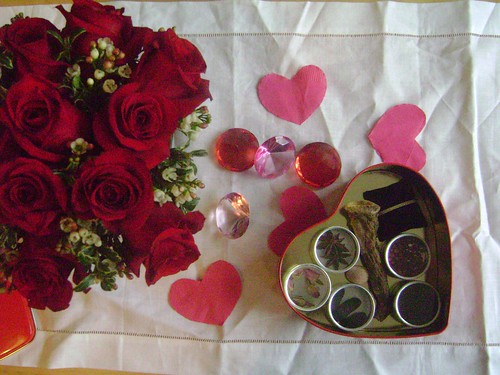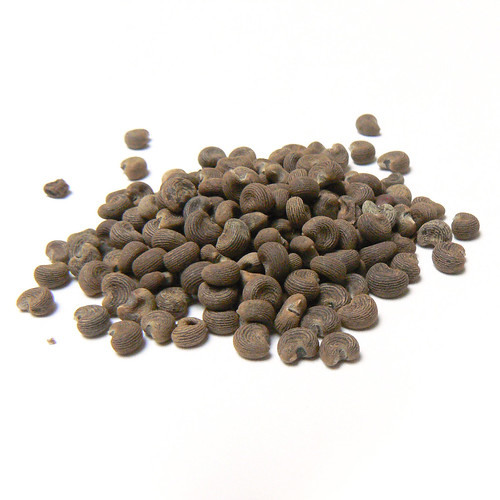Aphrodisiac of the Day: Ambrette Seed

Ambrette was discussed here before in other contexts, for example: in my article about vegetale musks, and how it was employed in my newest perfumed tea. Today I want to highlight its aphrodisiac qualities, and how you can use it creatively in your own kitchen (or the bedroom...).
Ambrette seed is the seeds of Abelmoschus moschatus - an evergreen shrub from the hibiscus family, with yellow flowers with purplish-pink centre. These little innocent looking seeds are the perfumer's best choice for replacing animal-musk, although admittedly, it's far more gentle, sublime and not as sharp as animal musk.
Ambrette seed has a subtle and sublime musky odour. It is warm, but not quite like what one would call "spicy" - if anything its complexity reminds me slightly of that of coriander seed, although it's not nearly as heady (coriander has citrus elements in its chemical makeup, due to molecules such as limonene; and also light woodsy floralcy from the linalol). Ambrette is also slightly floral (probably due to the farnesol content); but has a very distinct aroma of its own, hardly sharing anything with other fragrant plants I'm familiar with. Possessing wine-like, nutty and fruity aspects reminiscent of overripe fruit or even lychee (probably because of the isoambrettolide - a macrocyclic musk that has some "red fruit" or berry characteristics). It also has some palmitic acid (which gives it a "fatty" or "oily" aspect). But most importantly - it is very rich in ambrettolide, which smells like what we learned to identify as "white musk" - clean, sweet, slightly floral or even soapy, and with berry undertones as well.

Ambrette also has medicinal benefits as well: to ease indigestion, cramps and nervous dyspepsia, and also can be ground made into an emulsion with milk to treat itchy skin.
And of course - ambrette seed is considered an aphrodisiac, both as a perfume and incense material and also in its less known culinary uses. It is used as spice in the East, either on its own or within exotic spice blends such as Moroccan Ras El Hanout (which was originally an aphrodisiac spice blend, by the way, and often calls for animal ingredients such as Spanish Fly, ambergris or musk). Ambrette seeds are also used by Arabs to flavour coffee (much like they do with cardamom seeds). The tincture is used to flavour liquors and tobacco - although I doubt that either will do you much good as aphrodisiac agents!
For my 3rd annual aphrodisiac tea party in February 12th, 2012 I will be serving my guests ambrette seeds in the Ras El Hanout spice blend I'll create, and also will infuse them in chocolate ganache to create aphrodisiac white chocolate truffles. You may also want to think about infusing ambrette seed in warm milk alone or along with vanilla and orris - or add it to sahleb and warm puddings of that nature. They may also work wonders in semolina desserts (cookies, harissas, etc.) along with spices such as coriander, cardamom and rosewater - in which case you should grind them before use and add like you would any other spice.
It's very unlikely you will find ambrette seed in your local spice shop, so you will have to find it online. Look for shelled but whole, un-ground seeds, as the fatty and oily components inside the seeds can easily get rancid once exposed to the air, which will greatly affect the scent and aroma. It's the skin of the tiny seeds that possesses most of the aroma anyway, so grind just as much as you need for immediate use and store them whole in an airtight container and away from heat, light and moisture - where they will remain fragrant profile for years.
I adore ambrette seed as a perfume material and use it in countless of my perfumes, but most notably in Cabaret, Sahleb, Tamya, Espionage and Zangvil, where its subtle musky notes come through and greatly complement the floral, powdery and ambery notes. It's so delicate, and really brings out the best of florals. Together with the flower essences (i.e.: rose, orange blossom, jasmine and tuberose) it really transforms - similarly to ambergris - and opens up on on the skin to what is definitely what I would call an aphrodisiac.
Perfumes containing ambrette seeds calm the mind and make me feel connected to my own skin, and to me that's what aphrodisiacs should be all about. They don't necessarily need to transport you into a far away exotic land or make you feel like some mythological sex goddess or act as a non-stop viagra dispensing machine (not that one like that exists, last time I checked) - but silently turn a little key and make the necessary switch from the worries of everyday life into something more sensual and pleasing that allows for things to happen. I suspect the "trick" of ambrette seed is two-fold: the fact that it helps to ease stress and nervousness, and also its stark resemblance to human skin (it is, somewhat, reminiscent of the scent of a baby's head too!). So wear a perfume with an ambrette seed in its base, rather than a synthetic musk, and enjoy the subtle yet powerful action of true botanical aphrodisiac.
